#ecological harmony
Text
A Celebration of Fresh Beginnings and Deep Connections
Renewal Day: A Celebration of Fresh Beginnings and Deep Connections
May 4th marks Renewal Day, a holiday that aligns with the vibrant spirit of spring, ushering in new possibilities and reviving the various facets of our lives. As nature undergoes a rejuvenation, so does Renewal Day become a time for rebirth, regeneration, and the restoration of connections with nature, the environment, family,…

View On WordPress
#Arne Næss#biodiversity#Biodiversity Conservation#Celebrate#cherish nature#City Nature Challenge#Climate Action#collective commitment#commitment#commitment to nature#commitment to renewal#commitment to the environment#community#deep connection#deep ecology#Earth#Earth&039;s interconnected web#eco-friendly#Ecological Awareness#ecological balance#ecological harmony#ecological philosophy#ecological principles#ecological vision#Ecosystem#ecosystems#embrace#embrace nature#embrace renewal#enduring connections
0 notes
Photo

“Mycelium Modularity” by Dustin Wang,
“This drawing illustrates a forest that has been populated with housing pods made out of mycelium, conceptualizing the utilization of this material in modular architecture.
Mycelium, a natural fungi found in forests, can form rigid, water-resistant structures when molded and grown. Possessing a flexible form, this allows for the creation of these pods around trees and hills – existing in harmony with nature, rather than replacing it. The resulting effect are teardrop-like structures, differing in shape as each is hand-built.
In this scene, pollution is the origin of the hazy, grey sky. With plastic and waste reduction having become an everlasting consequence, mycelium is used in this small community of hopeful outliers, being a last ditch effort to slow down the deep-rooted repercussions of the changing climate.
In an inevitable future where the natural lives in the artificial, the increased awareness of the benefits of mycelium, will aid in revitalization.”
Courtesy: Architizer’s 4th Annual One Drawing Challenge
#art#conceptual#mycelium#modularity#dustin wang#drawing#illustration#pod#fungi#nature#backtoearth#forest#sustainability#ecology#harmony#climate change#architizer#one drawing challenge
54 notes
·
View notes
Text
Native American Spirituality: A Path of Harmony with the Earth
In a world facing pressing environmental challenges, the need for a sustainable and holistic approach to our relationship with the planet has become increasingly apparent. Native American spirituality offers a unique perspective that emphasizes a deep connection and reverence for the Earth. In this blog post, we will explore why Native American religion stands out as a path that holds valuable lessons for humanity's harmonious coexistence with nature.
1 - Ecological Wisdom: Native American religions have long recognized the interconnectedness of all living beings and the environment. They view nature as a sacred and interconnected web of life, where every entity, from animals and plants to rivers and mountains, possesses inherent value and deserves respect. This ecological wisdom teaches us the importance of living in harmony with the Earth and embracing sustainable practices that honor the delicate balance of ecosystems.
Example: The Navajo people's belief in the interconnectedness of all things is reflected in their concept of "Hózhǫ́ǫ́gįį́," which encompasses beauty, balance, harmony, and health. It promotes living in alignment with the natural world, acknowledging the interconnectedness of all living beings and the responsibility to maintain harmony within the environment.
2 - Stewardship and Conservation: Native American spirituality emphasizes the role of humans as stewards of the Earth rather than dominant rulers. The concept of stewardship recognizes our responsibility to protect and preserve the natural world for future generations. Many Native American tribes have traditionally practiced sustainable land and resource management, showing respect for the Earth's gifts and ensuring their responsible use.
Example: The Iroquois Confederacy's Great Law of Peace emphasizes the importance of considering the well-being of future generations in decision-making. This principle reflects a deep respect for the environment and a commitment to ensuring the continuity and sustainability of resources.
3 - Rituals and Ceremonies: Native American religions often incorporate rituals and ceremonies that foster a connection with nature and express gratitude for the Earth's abundance. These practices serve as reminders of our interconnectedness with the natural world and help cultivate a sense of reverence and respect for the environment.
Example: The Sun Dance ceremony, practiced by various Plains tribes, symbolizes renewal and the cycle of life. It involves fasting, prayer, and dancing in harmony with nature, reinforcing the bond between humans and the Earth.
4 - Spirituality in Everyday Life: Native American spirituality emphasizes the integration of spiritual beliefs into everyday life. It encourages a deep sense of awareness, gratitude, and mindfulness towards the natural world. This approach nurtures a profound respect for the Earth and fosters a sustainable way of living in harmony with nature.
Example: The concept of "Mitakuye Oyasin" among the Lakota people expresses the belief that all beings are interconnected and part of the same spiritual family. This understanding inspires a sense of responsibility and care for the well-being of all creatures and the environment.
Native American spirituality offers a valuable perspective on our relationship with the Earth, emphasizing ecological wisdom, stewardship, and a deep reverence for the interconnectedness of all life. By embracing these teachings and integrating them into our lives, we can cultivate a harmonious and sustainable approach to coexisting with the planet. The wisdom and practices of Native American religions serve as a profound source of inspiration and guidance as we navigate the environmental challenges of our time and strive to create a better future for generations to come.
#Native American spirituality#Environmental harmony#Ecological wisdom#Stewardship and conservation#Interconnectedness of life#Sustainability practices#Indigenous traditions#Rituals and ceremonies#Mindfulness in nature#Cultural diversity#Reverence for the Earth#Indigenous wisdom#Environmental responsibility#Harmony with nature#Interconnected spirituality#Sustainable living#Lessons from Native American traditions#Environmental consciousness#Spirituality and the environment#Cultivating reverence for the Earth#knowledge#learning#ethics#education#chatgpt#philosophy#epistemology#spirituality
6 notes
·
View notes
Text
A Summation of Three
Humans are corrupted files malfunctioning within the simulation.
We are devoid of the ability to live in harmony with our ecosystem.
We are the chronic parasite embedded upon the earth.
#truths89#poetry#zisa aziza#negressofsaturn#existentialism#spirituality#ecology#harmony#parasite#quaratine#devolution
2 notes
·
View notes
Text
Blurring the Lines
Embracing the Unity of Nature and the ArtificialEverything that is considered unnatural or artificial is, in fact, part of nature’s expression. This idea, at first glance, might seem contradictory. How can something artificial, a creation of human ingenuity, be natural? But this is where we need to expand our understanding of what nature encompasses.Nature, in its broadest definition, includes…

View On WordPress
#Artificial#Ecological Balance#Environmental Impact#Harmonious Coexistence#innovation#Interconnectedness#Nature#responsibility#Sustainable Development
1 note
·
View note
Text
Ecological harmony above ground equates to ecological complexity and harmony underneath.
"Soil: The incredible story of what keeps the earth, and us, healthy" - Matthew Evans
0 notes
Text


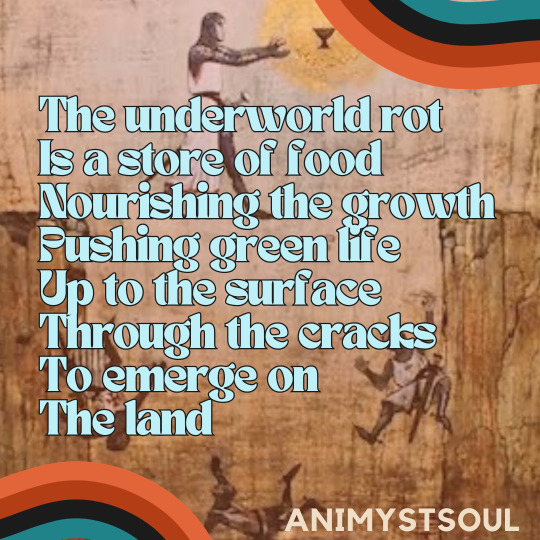


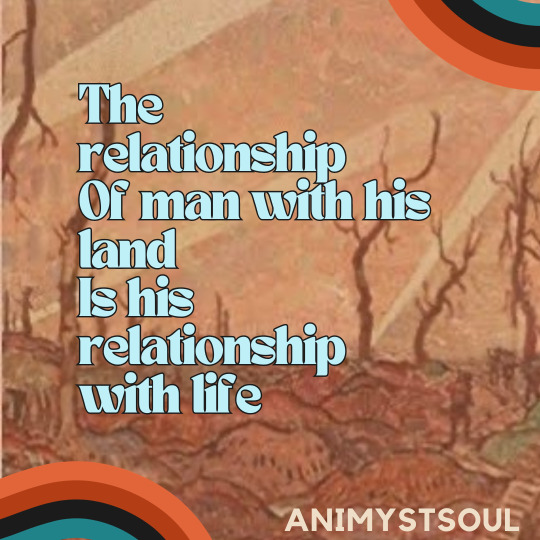


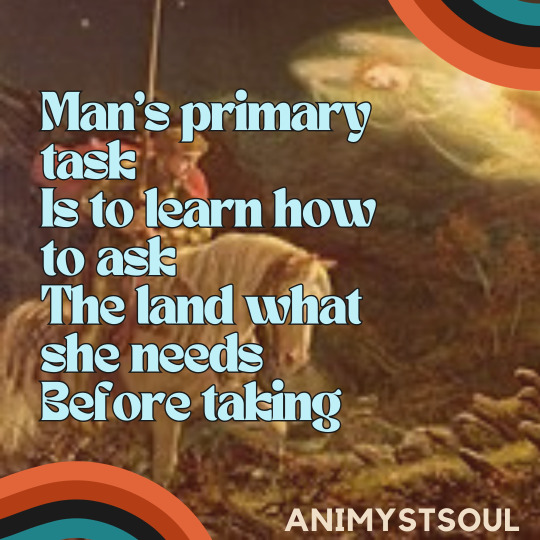
There is a cycle of life revolving between the land,
the underworld death landscape & the green life that grows through to the surface. A cycle that is regulated according to a supreme law, for man the law is a covenant to uphold— where the land has agreed to supply & support man's culture in turn to be worked & maintained by man's hands & labour.
Breaking the covenant by taking without asking leads to conflict in man's culture, the land needs its due, the sacrifice of energy to be returned to the underworld to feed the cycle of birth-life-&-death.
If it is not given by offering, the land claims it by turning into a wasteland.
#wasteland#grail#grail quest#nature#land#land magick#technology#temple technology#vibrational technology#magick#alchemy#ecospirituality#rta#witch#spiritual journey#ecospiritualism#manifestation#maat#harmonie#ecology#equilibrium#circle of life#great chain of being
1 note
·
View note
Text
Value pf Trees
rees hold immense value for our planet and well-being. They are the lungs of the Earth, absorbing carbon dioxide and releasing oxygen, crucial for our survival. Trees provide habitat for wildlife, support biodiversity, and contribute to ecological balance. Their shade and cooling effects reduce urban heat, conserving energy. Additionally, they prevent soil erosion, purify water, and enhance soil fertility. Economically, trees yield resources like wood, fruits, and nuts. Beyond tangible benefits, trees offer mental and emotional respite, promoting psychological well-being. Recognizing their ecological, economic, and psychological significance, conserving and planting trees is vital for a sustainable and harmonious world.
#rees hold immense value for our planet and well-being. They are the lungs of the Earth#absorbing carbon dioxide and releasing oxygen#crucial for our survival. Trees provide habitat for wildlife#support biodiversity#and contribute to ecological balance. Their shade and cooling effects reduce urban heat#conserving energy. Additionally#they prevent soil erosion#purify water#and enhance soil fertility. Economically#trees yield resources like wood#fruits#and nuts. Beyond tangible benefits#trees offer mental and emotional respite#promoting psychological well-being. Recognizing their ecological#economic#and psychological significance#conserving and planting trees is vital for a sustainable and harmonious world.
0 notes
Text

JINEN — Philosophy of Ecological LIFE in JAPAN
On this occasion we want to give you a green ecological touch if you have felt that call to be a little more environmentalist, ecologist, we can probably help you to have more ideas, or even to go a little further than what is normally known. And it is that what we want to talk about is the Jinen.
Jinen is a Japanese concept that refers to living like nature, that is, living as part of nature. They have probably realized that they are currently emphasizing that we live with nature, in short, that we are superior to nature, we can make and unmake it as we want, we have to dominate nature to continue growing.
Undoubtedly in recent years, society’s concept of our position in nature and how we use it has improved a little, going from “it must be mastered, it must be changed, it must be transformed”, to now saying “we must live with nature, you have to learn to live with nature”. And it’s not bad, it’s an improvement between destroying it, dominating it, living with nature, but I think it should go further.

Perhaps now we ask ourselves, how can we reach the Jinen, or what is the ideal, because it is not just about deciding that today I am already part of nature. In Japan there is talk of a whole process that is simple in concept, but complicated in implementation. It all starts with something similar to traditional environmentalism or ecology, how can we take care of nature, how can we restore nature, what if global warming, and all these issues that we have become accustomed to in modern society, but unfortunately present to us distanced from nature. We talk about these issues as if they do not involve us, as if we are in a great position of power, outside, superior, from which we can repair or break the system.
Continue Reading >>>
0 notes
Text
OSIFU 13: TEN REASONS FOR THE CURRENT GLOBAL CRISIS
Today is August 19, 2013, Monday, sunny, still hot. Everything in the small town where Osifu lives is melting, the leaves all wilted, and some have already dried up. Looking through the window, everything as far as the eye can see is dazzling, reflecting the light of the sun. Under the strong sunlight, there are few pedestrians, and the road, rarely, is peaceful.
At this time the sun can not be…

View On WordPress
#ascent#awareness#chain reaction#cooperation#development#earth#ecological#energy#global crisis#harmony#imbalance#intelligence#laws of nature#natural disasters#polluted#population#science#scientist#solar#solar system#sun#technological development#universe
0 notes
Text
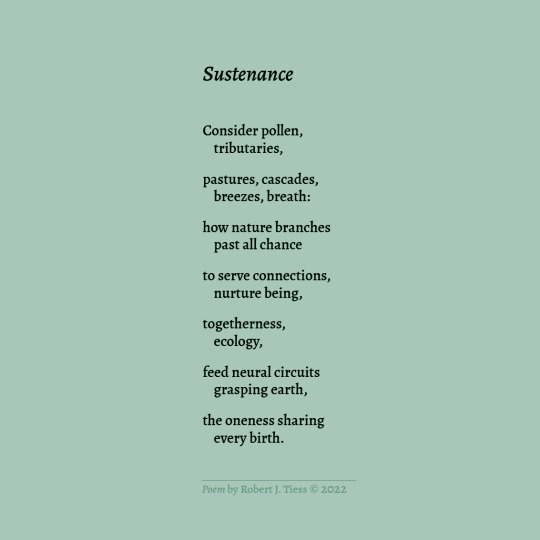
My poem "Sustenance"
Thank you for reading this.
Poem text link:
https://allpoetry.com/poem/16892259-Sustenance-by-Robert-J.-Tiess
#poem#poems#poetry#poetrylovers#poetrycommunity#readingcommunity#naturelovers#nature#ecology#ecopoetry#environment#harmony#interconnectedness#unity#earth#life#metaphors
1 note
·
View note
Text
Reconnecting with Nature: A Prescription for World Health Day

View On WordPress
#Air Pollution#Ancestral Wisdom#biodiversity#City Nature Challenge#Climate Action#climate crisis#Climate Justice#Community Engagement#conservation#Conservation Efforts#conservation initiatives#Cree Law#CULTURAL HERITAGE#Earth Awareness#Earth Celebration#Earth Consciousness#Earth day#Earth Harmony#Earth&039;s Health#Earth-centered Living#eco-awareness#Eco-centric Philosophy#eco-consciousness#Eco-literacy#Eco-philosophy#Eco-psychology#Eco-spirituality#Ecological Awareness#ecological balance#ecological harmony
0 notes
Text
Eco Biodiverse Tiny House Communities with shared commons towards re-wilding and protecting the natural world
Eco Biodiverse Tiny House Communities with shared commons towards re-wilding and protecting the natural world
I propose building tiny house communities to provide affordable housing, with an emphasis on living harmoniously with biodiversity in a clean and sustainable manner within the local geophysical environmental parameters.
The community members investment prioritizes clean land, water, energy, transportation, shared gardens – as part of an ‘economic’ commons – in which shared ownership encourages…
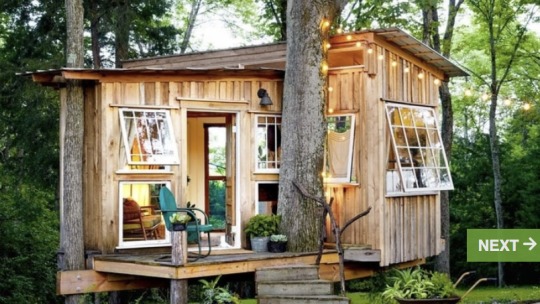
View On WordPress
#affordable housing#‘Tiny House Communities’ With Big Potential#Balance#bee highways#commons#ecology#environmental harmony#harmony#harmony with nature#health#Kayti Christian#pollinators#Sustainability#Tiny Home Communities Inspiring Minimal And Collective#tiny house#tiny house community
0 notes
Text
The Philosophy of the Bird
The philosophy of the bird encompasses contemplations on avian behavior, symbolism, and their relationship to human existence and the natural world. While birds do not engage in philosophical inquiry as humans do, their presence and characteristics inspire reflections on various philosophical themes. Here are some aspects of the philosophy of the bird:
Freedom and Flight: Birds are often associated with freedom due to their ability to soar through the skies. Philosophical discussions on bird flight may explore themes of liberation, transcendence, and the pursuit of higher perspectives.
Adaptation and Survival: Birds have evolved diverse adaptations to thrive in different environments. Philosophical reflections on avian adaptation may delve into the concept of resilience, the balance between stability and change, and the importance of flexibility in navigating life's challenges.
Symbolism and Spiritual Significance: Birds hold symbolic meaning in many cultures and spiritual traditions. Philosophical inquiries into bird symbolism may examine themes of transcendence, spirituality, communication with the divine, and the pursuit of enlightenment.
Perception and Awareness: Birds possess keen senses and perceptual abilities that shape their interactions with the environment. Philosophical musings on avian perception may explore the nature of consciousness, sensory experience, and the subjective interpretation of reality.
Migration and Journey: Many bird species undertake long migratory journeys across vast distances. Philosophical reflections on bird migration may contemplate themes of exploration, journeying, and the quest for meaning and purpose in life.
Harmony with Nature: Birds are integral components of ecosystems, playing roles in pollination, seed dispersal, and insect control. Philosophical discussions on birds' ecological significance may highlight the interconnectedness of all living beings and the importance of preserving biodiversity.
Creativity and Expression: Birds are known for their diverse vocalizations and intricate nest-building behaviors. Philosophical explorations of avian creativity may consider the nature of artistic expression, innovation, and the drive to create beauty in the world.
Time and Seasonality: Birds' behavior often follows seasonal patterns, such as breeding, nesting, and migration. Philosophical reflections on avian temporality may examine concepts of cyclicality, change, and the rhythm of life.
Vulnerability and Resilience: Birds face various threats in their environments, including habitat loss, pollution, and climate change. Philosophical inquiries into bird vulnerability may touch upon themes of fragility, adaptation, and the ethical responsibilities of humans toward other species.
In summary, the philosophy of the bird encompasses a diverse range of contemplations on freedom, adaptation, symbolism, perception, migration, harmony with nature, creativity, temporality, vulnerability, and resilience. While birds themselves do not engage in philosophical discourse, their existence and behavior inspire humans to reflect on fundamental questions about life, meaning, and our place in the world.
#philosophy#epistemology#knowledge#learning#chatgpt#education#ontology#ethics#metaphysics#Freedom#Adaptation#Symbolism#Perception#Migration#Harmony with nature#Creativity#Time#Vulnerability#Resilience#Spirituality#Consciousness#Ecology#Transcendence#Exploration
1 note
·
View note
Text
The history of Solarpunk

Okay, I guess this has to be said, because the people will always claim the same wrong thing: No, Solarpunk did not "start out as an aesthetic". Jesus, where the hell does this claim even come from? Like, honestly, I am asking.
Solarpunk started out as a genre, that yes, did also include design elements, but also literary elements. A vaguely defined literary genre, but a genre never the less.
And I am not even talking about those early books that we today also claim under the Solarpunk umbrella. So, no, I am not talking about Ursula K. LeGuin, even though she definitely was a big influence on the genre.
The actual history of Solarpunk goes something like that: In the late 1990s and early 2000s the term "Ecopunk" was coined, which was used to refer to books that kinda fit into the Cyberpunk genre umbrella, but were more focused on ecological themes. This was less focused on the "high tech, high life" mantra that Solarpunk ended up with, but it was SciFi stories, that were focused on people interacting with the environment. Often set to a backdrop of environmental apocalypse. Now, other than Solarpunk just a bit later, this genre never got that well defined (especially with Solarpunk kinda taking over the role). As such there is only a handful of things that ever officially called themselves Ecopunk.
At the same time, though, the same sort of thought was picked up in the Brazilian science fiction scene, where the idea was further developed. Both artistically, where it got a lot of influence from the Amazofuturism movement, but also as an ideology. In this there were the ideas from Ecopunk as the "scifi in the ecological collaps" in there, but also the idea of "scifi with technology that allows us to live within the changing world/allows us to live more in harmony with nature".
Now, we do not really know who came up with the idea of naming this "Solarpunk". From all I can find the earliest mention of the term "Solarpunk" that is still online today is in this article from the Blog Republic of Bees. But given the way the blogger talks about it, it is clear there was some vague definition of the genre before it.
These days it is kinda argued about whether that title originally arose in Brazil or in the Anglosphere. But it seems very likely that the term was coined between 2006 and 2008, coming either out of the Brazilian movement around Ecopunk or out of the English Steampunk movement (specifically the literary branch of the Steampunk genre).
In the following years it was thrown around for a bit (there is an archived Wired article from 2009, that mentions the term once, as well as one other article), but for the moment there was not a lot happening in this regard.
Until 2012, when the Brazilian Solarpunk movement really started to bloom and at the same time in Italy Commando Jugendstil made their appearance. In 2012 in Brazil the anthology "Solarpunk: Histórias ecológicas e fantásticas em um mundo sustentável" was released (that did get an English translation not too long ago) establishing some groundwork for the genre. And Commando Jugendstil, who describe themselves as both a "Communication Project" and an "Art Movement", started to work on Solarpunk in Italy. Now, Commando Jugendstil is a bit more complicated than just one or the other. As they very much were a big influence on some of the aesthetic concepts, but also were releasing short stories and did some actual punky political action within Italy.
And all of that was happening in 2012, where the term really started to take off.
And only after this, in 2014, Solarpunk became this aesthetic we know today, when a (now defuct) tumblr blog started posting photos, artworks and other aesthetical things under the caption of Solarpunk. Especially as it was the first time the term was widely used within the Anglosphere.
Undoubtedly: This was probably how most people first learned of Solarpunk... But it was not how Solarpunk started. So, please stop spreading that myth.
The reason this bothers me so much is, that it so widely ignores how this movement definitely has its roots within Latin America and specifically Brazil. Instead this myth basically tries to claim Solarpunk as a thing that fully and completely originated within the anglosphere. Which is just is not.
And yes, there was artistic aspects to that early Solarpunk movement, too. But also a literary and political aspectt. That is not something that was put onto a term that was originally an aesthetic - but rather it was something that was there from the very beginning.
Again: There has been an artistic and aesthetic aspect in Solarpunk from the very beginning, yes. But there has been a literary and political aspect in it the entire time, too. And trying to divorce Solarpunk from those things is just wrong and also... kinda misses the point.
So, please. Just stop claiming that entire "it has been an aesthetic first" thing. Solarpunk is a genre of fiction, it is a political movement, just as much as it is an artistic movement. Always has been. And there has always been punk in it. So, please, stop acting as if Solarpunk is just "pretty artistic vibes". It is not.
Thanks for coming to my TED Talk, I guess.

#solarpunk#solarpunk aesthetic#solarpunk fiction#political movement#history#history of solarpunk#amazofuturismus#put the punk back in solarpunk#scifi#science fiction#clifi#climate fiction#ecopunk
3K notes
·
View notes
Text
Don't understand why more people don't appreciate programming as a creative artform. It's one of my most self-indulgent admissions but programming an environment is like playing at being a God to me. I get to create swarms of little attendant automatons like biblical angels that contribute to the mechanism of the bespoke ecosystem I am crafting, and they all turn together in perfect harmony. If I could find a way to represent the interaction of data structures visually I could put this shit in a museum as a whirling sculpture that plays its own hand-shaped swarm ecology.
1K notes
·
View notes